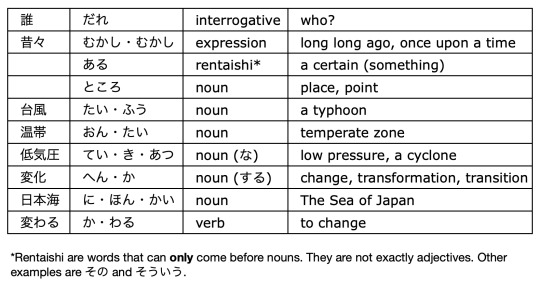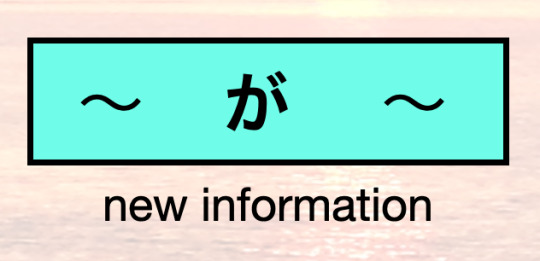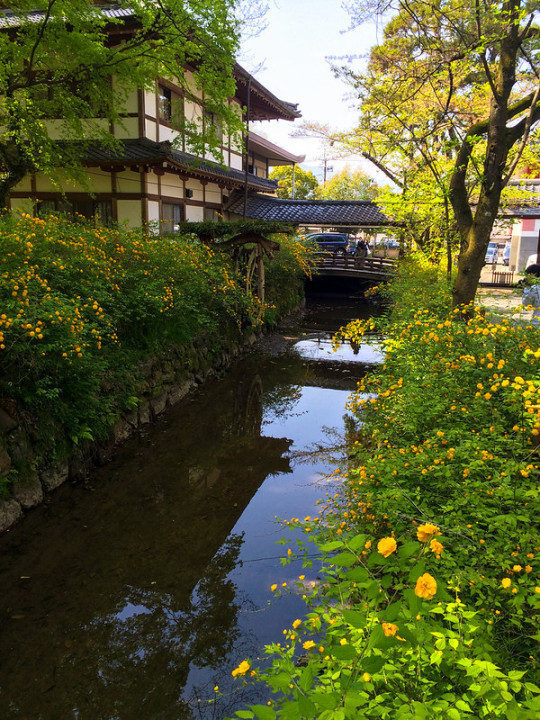| Ann, 28, German.Follow me on my language journey, as I attempt to learn languages by myself.Follow me on instagram! Buy me a ☕!
Don't wanna be here? Send us removal request.
Photo

Time to learn the name of delicious fruits! I love cherries (버찌), what about you? ♥
47 notes
·
View notes
Text
11.8) The が Particle [Part 1]
The last particle we should look at is が. I know that I basically started this blog off by talking about が, but it doesn’t hurt to refresh your memory, right? Hopefully this post can shed some new light on JUST how important the が particle really is. Here is your vocabulary for this post, served fresh!

【Communicating New Information】
The point of any language is to communicate new information. Different languages use different grammar to do this, but it is the basis of human communication. When it comes to Japanese, there are actually three different ways that the language communicates new information, and they all involve the が particle! Let’s take a look, shall we?
【Method 1】
First is the typical way. The topic is introduced by は… Maybe “introduced” isn’t the best word to use because it’s not actually new information. The topic will always be something that the listener / reader is already familiar with. That’s why I often use “as for…” or “you know…” in my translations. To some extent, the listener should already have a clue what the topic is. It’s very similar to how we use the article “the” in English. If you randomly say, “I saw the cat yesterday” to a friend, they won’t know what in the world you’re talking about unless you have talked about that specific cat before.
At any given time, this topic is floating above the conversation. As the conversation flows, the topic is constantly refreshed and changed. Things that are new information can quickly become the new topic. However, the speaker has to bring attention to this new topic first.
After you bring attention to the topic, you make a comment / comments about it until a new topic is brought up. These comments are where the new information comes in. Sometimes, the subject will be marked by が while other times there will be an invisible subject (when the subject and the topic are the same thing). We talked about this way back in this post. Here is a visual aide for you:

【Method 2】
The second method of introducing new information is where が is used for emphasis. In these kinds of sentences, the part of the comment that comes after が is NOT new information. The new information is what comes before が. When Japanese speakers ask questions, they often use this construction. Here is another visual aide to help you:

Here is an example:
①{誰が}{ジュースを飲んだ}の?
= Who? (as the subject) drank the juice. Also, explain.
= Who drank the juice? (the nuance is that the person asking wants details)
In example 1, it would already be known that someone drank the juice, right? The question (unknown information) is WHO. The answer will tell you who drank the juice, but in the meantime you use the question word 誰 and mark it with が. It temporarily holds the place of the new information that you will receive.
【Method 3】
The third and final method for introducing new information is sometimes called the “news が.” There is no particular emphasis on what comes before or after the が. It’s ALL new.

Here are some examples:
② 昔々、あるところに{おじいさんとおばあさんが}{**いました}。
= Long long ago, an old man and woman existed.
= There once lived an old man and woman.
This example comes from the Japanese fairy tale called Momotarō and is typical of fairy-tale-style openings. Before we heard this sentence we didn’t know about the old man or woman. We also didn’t know that they lived (of course!). Since this is all new information, instead of は, the が particle is used.
③ {台風12が}{温帯低気圧に変化}
= Typhoon #12 (as the subject) change to a temperate cyclone
= Typhoon 12 (has) changed to a temperate cyclone.
Example 3 came from LINE (the most commonly-used messenger app in Japan) News. You would expect this to be a typical news article heading because it uses method 3, which is the news が (also because there is no verb, adjective or copula bundle at the end). News stories often use this third method to simply introduce information. As soon as you start reading the article, は can be attached to either 台風12 or 温帯低気圧に変化 because they instantly become “already-known information”. In fact, the first line of the article says:
8月24日 (火) 9時に、台風12は日本海で温帯低気圧に変わりました。
= on Aug. 24th at 9 AM, you know Typhoon 12? at the Sea of Japan, (it) changed into a temperate cyclone
= On Aug. 24th at 9AM, Typhoon 12 at the Sea of Japan changed into a temperate cyclone.
Keep in mind that if a writer chooses to start a story or article with は, it is a deliberate choice. Sometimes writers want to throw us into the world of the story right away. Using は on purpose instead of this third method is a very common technique used in Japanese writing to immerse the reader as soon as possible.
【Two Versions of が】
Now might be a good time to mention that you have actually seen two different versions of the が particle! There is the exhaustive が and the neutral が.
The exhaustive (or focus) が places emphasis on whatever it’s attached to. It assumes that the topic is information that the listener / reader already knows. が is the particle that marks the new information. This が is what you saw in methods 1 and 2.
On the other hand, the neutral (or news) が spreads out the emphasis to the whole sentence. This makes the whole sentence new information. This が appears in method 3.
It’s very subtle, but in spoken conversation you can sometimes actually hear the difference in stress between the two が particles! Since one of them places emphasis on something, and the other doesn’t, native speakers do distinguish between the two (even if they are not aware of it).
【Conclusion】
In this post we looked at the Japanese language’s 3 ways of introducing new information. In my first few posts I stressed that the が particle always marks the subject of the sentence. While this is true, now I can tell you that even more importantly, が is always associated with marking new information.
I have one last post about the が particle coming up next, so keep a look out for that. In the meantime stay safe, and keep those likes, questions, mentions and reblogs (with really funny hashtags!) coming, I REALLY appreciate them and I appreciate YOU. Remember, when it comes to Japanese, never stop learning!
Rice & Peace,
– AL (アル)
👋🏾
** Some versions of Momotarō use 住んでいました instead of いました. I even came across some versions that used おりました, which is just another way to say いました.
255 notes
·
View notes
Text

에 VERSUS 에서
At vs At? What's The Difference?
What is 에?
에 is a particle used in Korean sentences. It's is attached after a noun and used to mark time/place. It has the meaning of
(at, in, on, to) in English. However, It doesn't always need to be translated that way, as long as It's there you know that a time or place is being talked about.
Examples -
한국에 (In Korea, At Korea, To Korea)
학교에 (At school, To school)
아침에 (In the morning)
이월에 (In February)
What's The Difference Between 에 & 에서?
에 is used to mean 'at' as in 'to be at a place/location'
> when you use this, there's no indication that you will be/are doing anything at that place. It only tells where you are at.
에서 is used to mean 'at' as well. However, you only use this one when you want to tell WHAT you are doing AT a place/location. There will always be a verb somewhere in these sentences. But that doesn't mean there aren't verbs used with ~에.
> Important to note: you won't see 에서 used when marking time so keep that in mind
Example Sentences:
1.) 민수 씨는 집에 있어요.
(Minsu is at home.)
> 에 is used to simply tell his location. we don't know what Minsu is doing at home, only that he is there.
2.) 민수 씨는 집에서 쉬어요.
(Minsu is resting at home.)
> 에서 is used because we know what action Minsu is doing at home.
3.) 저 식당은 카페 옆에 있어요.
That restaurant is next to a cafe.
4.) 우리는 카페에서 커피를 주문해요.
We order coffee at the cafe
-에 Grammar Exceptions
1.) 에 can't be used with 어제 (yesterday), 오늘 (today), 내일 (tomorrow), 지금 (now)
2.) You can not use 에 on the first time noun. If there are 2 time related nouns.
For example: 다음 주 금요일 (4)네시에 결혼해요.
Next Friday at 4 pm is the wedding.
Notice 에 is placed at the end, after all of the times listed here.
Now Practice Doing So For Yourself:
It can be tricky sometimes to tell the difference~
에 vs 에서 practice:
소라 씨는 도서관___ 책을 읽었어요.
Sora read a book in the library.
우리는 월요일___ 만날거예요.
We'll meet on Monday
존 씨는 공원___ 놀고 있어요.
John is playing at the park.
학교 옆___ 약국이 없어요.
There is no Pharmacy next to the school.
저는 화장실___ 가요.
I am going to the restroom.
팀 씨는 영화관___ 영화를 볼거예요.
Tim will watch a movie with us.
ANSWERS SECTION:
소라 씨는 도서관에서 책을 읽었어요.
Sora read a book in the library.
우리는 월요일에 만날거예요.
We'll meet on Monday
~ remember: 에서 isn't used when marking time
존 씨는 공원에서 놀고 있어요.
John is playing at the park.
학교 옆에 약국이 없어요.
There is no Pharmacy next to the school.
~ most of the time 에 is used with 있어요/없어요
저는 화장실에 가요.
I am going to the restroom.
~ they are going TO the restroom. However, they are not talking about what they are doing IN the restroom
If they said something like "I'm dancing in the restroom" then you would use -에서
팀 씨는 영화관에서 영화를 볼거예요.
Tim will watch a movie with us at the movie theatre/cinema
89 notes
·
View notes
Photo





https://www.linguajunkie.com/japanese/funny-japanese-phrases
115 notes
·
View notes
Text

went to go see the beautiful hydrangeas at asukayama park in ōji, tokyo.
今年も王子駅飛鳥山公園の紫陽花を見に行きました。
vlog
189 notes
·
View notes
Text
'no matter' ようと(も)、ようが、ようがまいが
This is a concessive construction meaning 'no matter X, Y' or more verbosely 'it doesn't matter that...X, still Y'. It's pretty transparently formed; take the volitional -ou ending, stick either ga, to, or tomo. -i adjectives drop -i and take karou, -na adjectives and nouns take darou.
A few nice examples scoured from various webpages (all English translations my own): 誰が何と言おうと、わたしの決意は変わりません。
No matter what anyone says, I'm not changing my mind.
使わないものは、いくら安かろうと買う必要はない。
There's no need to buy things you don't use, no matter how cheap they are.
The construction can be extended with negative volitional form -まい (I might make a separate post about this), with the corresponding particle from the よう, so Vようが...Vまいが or Vようと...Vまいと. It's always used with the same verb, i.e. 'whether you do or you don't'.
早く出ようが出るまいが、電車が遅れれば遅刻する。
[No matter] whether you leave early or not, if the train's late then you'll be late.
P.S. I've just reached the end of the post and realised that this seems to be related to the underlying structure for the ubiquitous しようがない, or しょうがない 'nothing you can do; it can't be helped'?
164 notes
·
View notes
Text
any ounce or even half ounce of trying is better than no trying
555 notes
·
View notes
Text
Miscellaneous Everyday Korean Vocab! (Informal) - 다양한 일상 한국어 어휘! (반말)

그럼 난 이만 - I’m gonna get going (then).
이만자야겠다 - I think I’m gonna go to sleep now.
이만가야겠다 - I think I’m gonna go now.
출구는 이/저 쪽이야 - The exit is this/that way.
이런건 식은 죽 먹기지 - This is a piece of cake (literally: this is like eating cold porridge).
식은 죽 먹기였어 - It was a piece of cake.
무슨 개 소리야? - What is this bullshit?/What are you saying?
난 이제 자유야! - I’m now free!
영어도 백범 맞는데 - I even got 100%/full marks/a perfect score in English.
거짓말이야 - It’s a lie.
사랑했나봐 - It must have been love.
사랑하나봐 - It must be love/I think it’s love.
비켜 - Move out the way/Step aside/Coming through.
버스에서 내려라 - Get off the bus.
이래 봬도... - Even though I look like this.../Even though you think I am...
방에 콕 박혀있다 (abbreviated to: 방콕) - I’m stuck in my room.
알겠지? - You know that right?/Okay?/Got it?
실패했어 - I failed.
동영상 - Video/Moving Image.
영상 - Still Image/Picture (also used to abbreviate 동영상 so it can also mean video).
진짜로? - For real? (can be cutely said as 진짜루?)
뭐 설레는거 없어?! - There’s nothing exciting?!
같이 사는 남자들은? - You’re living with men?
육조 물 받아놨어 - I put water in the bathtub/I ran a bath.
육조 - Bathtub (noun ONLY).
목욕 - Bath (noun).
목욕하다 - Bathing/Bathe (verb).
하겠냐?! - Would you do it?!
같이 사는 사람들 이름도 몰라! - I don’t even know the name of the people I live with!
멍청아! - Idiot!
모른채로 - Without knowing.
805 notes
·
View notes
Text
Hanja Idioms(사자성어) - ㄱ
고진감래 苦盡甘來
苦 쓰다 bitter 盡 다하다 to exhaust 甘 달다 sweet 來 오다 to come
After bitterness comes sweetness.
After hardship comes joy.
금상첨화 錦上添花
錦 비단 silks 上 위 top 添 더하다 to add 花 꽃 flower
To add flower on top of silks.
Good things added to good things.
괄목상대 刮目相對
刮 눈을 비비다 to rub one’s eyes 目 눈 eye 相 서로 each other 對 대하다 to treat
Rub one’s eyes and look at the other person.
A person’s learning and skill have improved surprisingly.
감언이설 甘言利說
甘 달다 sweet 言 말씀 words 利 이롭다 beneficial 說 말씀 words
Sweet words and beneficial stories(words).
Words adorned to suit others’ preferences or words that seem plausible with favorable conditions.
결자해지 結者解之
結 맺다 to tie, bind/to form 者 사람 person 解 풀다 to untie, untangle/to solve 之 그것 that (어조사, grammatical Hanja)
One who tied it must untie it.
The problems you’ve created must be solved by yourself.
각골난망 刻骨難忘
刻 새기다 to engrave 骨 뼈 bone 難 어렵다 difficult 忘 잊다 to forget
Be hard to forget because it’s engraved on the bones.
The kindness one has shown is too great to be forgotten.
개과천선 改過遷善
改 고치다 to fix 過 허물 fault 遷 달라지다 to change/to move 善 착하다 kind, nice
To correct the mistakes and faults in the past and become a good person.
과유불급 過猶不及
過 지나치다 excessive 猶 오히려 rather 不 아니 not 及 미치다 to reach, meet
Being excessive is the same as lacking.
구밀복검 口蜜腹劍
口 입 mouth 蜜 꿀 honey 腹 배 stomach(belly) 劍 칼 sword
Honey in the mouth and a sword in the stomach.
To seem to be kind and friendly but is intending to harm you.
권선징악 勸善懲惡
勸 권하다 to promote, recommend 善 착하다 good, kind 懲 징계하다 to discipline, punish 惡 악하다 evil
To encourage the good and discipline the bad.
근묵자흑 近墨者黑
近 가깝다 to be close 墨 먹 ink stick 者 사람 person 黑 검다 black
One who stays close to ink turns black.
Being around bad friends gets you into bad habits.
군계일학 群鷄一鶴
群 무리 group, herd 鷄 닭 chicken 一 한 one 鶴 학 crane
One crane in a flock of chickens.
One outstanding person in a group of ordinary people.
-Written and edited by Admin Yu
338 notes
·
View notes











